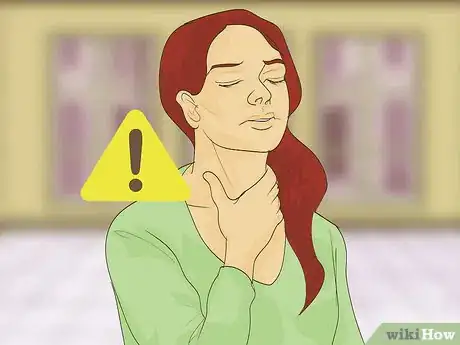This article was co-authored by wikiHow Staff. Our trained team of editors and researchers validate articles for accuracy and comprehensiveness. wikiHow's Content Management Team carefully monitors the work from our editorial staff to ensure that each article is backed by trusted research and meets our high quality standards.
There are 7 references cited in this article, which can be found at the bottom of the page.
This article has been viewed 166,659 times.
Learn more...
Whistle register is a unique range that many people aren’t capable of hitting. Projecting in whistle register requires many basic singing techniques with slight adjustments for the high pitch. Always stand upright and open your throat for good airflow. Keep your chin down for more power and release a steady stream of air to maintain the notes. Seek help from an instructor to learn proper techniques and practice emphasizing your vowel sounds. Whistle register tightens your vocal cords more than other singing, so always practice safety and stop if your throat starts to feel strained.
Steps
Putting Power Behind Your Voice
-
1Maintain good singing posture. Always keep your head held high and your shoulders relaxed down and slightly back. Hold your chest out firmly. Set your feet shoulder width apart and lean slightly forward onto the balls of your feet. Keep your stomach muscles tight but ready to expand when you breathe deeply.[1]
- A good posture will give you great diaphragm support and lung capacity, but this will vary depending on your style of singing and music genre.
-
2Stand still while you sing. Resist the temptation to sway, bounce, or walk around. Keep your hands still and don’t fidget. Focus all of your energy on your breathing and your voice. Moving and fidgeting detract from your concentration. Plant your feet and let your arms hang loosely by your sides.Advertisement
-
3Keep your throat open. Work on opening your throat as much as possible to let lots of air pass from your lungs out through your mouth. You can open up your throat by dropping your jaw and larynx. Push your tongue forward and widen the space between the back of your tongue and your throat.[2]
-
4Keep your chin down. Singers often raise their chin for more power, but this actually causes damage over time. When you are about to increase your power, keep your chin level. This technique eliminates the strain on your vocal cords, while also adding power to your voice.[3]
- As you work on higher notes and enter the whistle register, notice a natural tendency to lift your chin and actively work against that tendency. It takes practice to retrain yourself, but it increases your power.
-
5Regulate your airflow. It’s tempting to force a lot of air through your throat at once, but this can damage your vocal cords. Work on developing a continuous airflow from the start of the note to the finish. Mastery of breath management is an important prerequisite for singing in the whistle register.
- Practice breathing deeply and slowly releasing the air. Let the air out as slowly as possible to increase your endurance.
- Use this practice technique with a whistle note making it last as long as you can.
Improving Your Technique
-
1Take lessons from a coach. Whistle register is not a singing style that you can easily learn on your own. In many cases it isn’t safe to try it without proper instruction. If you have a singing coach already, tell them you want to work on your whistle register. Ask them how to improve your technique.
- If you don’t have a vocal coach already, search one out who has worked with singers on their whistle register. If they have experience with it, they will be able to give you better advice.
-
2Emphasize clear vowel sounds. Crisp vowels are important in whistle register like they are in all other ranges. The vowel sounds that you need to master are Ah, as in father, Eh, as in met, Ee as in feet, Oh, as in dome, and Oo, as in shoe. Practice forming these vowel sounds in your whistle register.[4]
- To practice this, look at the lyrics to one of your favorite songs. Make a list of the phrases that contain words with these vowel sounds. Sing those lines entering your whistle register on the words with strong vowel sounds.
-
3Stop if you feel any discomfort, pain, or tickling in your throat. Always practice your whistle register safely. Because your vocal cords are tighter in whistle register than they are at other times, you may strain them as you work on the technique. If at any point your throat starts to feel uncomfortable, stop immediately.[5]
- Take a break for a while and let your vocal cords rest. Never push past the point when you begin to hurt because you will end up damaging your vocal cords.
Preventing Vocal Strain
-
1Hydrate before, during, and after performances. Keep your throat moist when singing in whistle register because the strain is greater than when singing in other ranges. Drink lots of water around your performance. Stay away from alcohol and caffeine before performances because both substances dry out your throat.[6]
-
2Talk quietly before a performance. Talking loudly puts more strain on our vocal cords than talking at a normal volume. If you talk loudly, or talk for a long time, you put extra strain on your vocal cords besides the strain of singing. Don’t talk for long periods of time the day of your show and definitely don’t yell.
-
3Warm up before every performance. Any time you are going to sing, you should warm up your mouth, jaw, and vocal cords. Perform a few exercises like singing through your scales and trilling your tongue and lips. Work upward through your notes to reach the whistle register. Never jump straight into notes in the whistle register.[7]
Community Q&A
-
QuestionHow do I have a good singing voice?
 Community AnswerJust practice anytime and anywhere you can. It does not matter how you sound now, because you will eventually get better. Practice makes perfect.
Community AnswerJust practice anytime and anywhere you can. It does not matter how you sound now, because you will eventually get better. Practice makes perfect. -
QuestionIs it normal for some singers to have a loud whistling volume?
 Community AnswerYes. It actually can be a good thing, since a whistler whistles to be heard.
Community AnswerYes. It actually can be a good thing, since a whistler whistles to be heard. -
QuestionIs there an app in iOS that can determine my singing range?
 Community AnswerThere is an app called insTuner that tells you the pitch of any note you sing. You could use that (or something like a tuned piano) to find your range.
Community AnswerThere is an app called insTuner that tells you the pitch of any note you sing. You could use that (or something like a tuned piano) to find your range.
References
- ↑ http://takelessons.com/blog/singing-posture
- ↑ http://www.dummies.com/art-center/music/singing/dropping-your-larynx-for-a-full-open-singing-voice/
- ↑ https://www.caricole.com/5-secrets-to-make-your-voice-sound-better/
- ↑ https://spinditty.com/learning/How-to-Sing-the-Five-Basic-Singing-Vowels
- ↑ http://takelessons.com/blog/sing-like-mariah-carey-z02
- ↑ https://www.nidcd.nih.gov/health/taking-care-your-voice#4
- ↑ http://www.entnet.org/content/vocal-warmup-put-your-best-voice-forward






































































